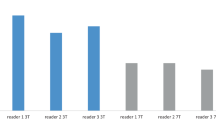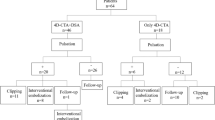Abstract
Purpose
To prospectively evaluate non-contrast-enhanced 7-Tesla (T) MRA for delineation of unruptured intracranial aneurysms (UIAs) in comparison with DSA.
Material and methods
Forty patients with single or multiple UIAs were enrolled in this IRB-approved trial. Sequences acquired at 7 T were TOF MRA and non-contrast-enhanced MPRAGE. All patients additionally underwent 3D rotational DSA. Two neuroradiologists individually analysed the following aneurysm and image features on a five-point scale in 2D and 3D image reconstructions: delineation of parent vessel, dome and neck; overall image quality; presence of artefacts. Interobserver accordance was assessed by the kappa coefficient.
Results
A total of 64 UIAs were detected in DSA and in all 2D and 3D MRA image reconstructions. Ratings showed comparable results for DSA and 7-T MRA when considering all image reconstructions. Highest ratings for individual image reconstructions were given for 2D MPRAGE and 3D TOF MRA. Interobserver accordance was almost perfect for the majority of ratings.
Conclusion
This study demonstrates excellent delineation of UIAs using 7-T MRA within a clinical setting comparable to the gold standard, DSA. The combination of 7-T non-enhanced MPRAGE and TOF MRA for assessment of untreated UIAs is a promising clinical application of ultra-high-field MRA.
Key Points
• Non-enhanced 7-T MRA allowed excellent delineation of unruptured intracranial aneurysms (UIAs).
• Image quality at 7-T was comparable with DSA considering both sequences.
• Assessment of UIAs is a promising clinical application of ultra-high-field MRA.



Similar content being viewed by others
Abbreviations
- 7-T:
-
7-Tesla
- CNR:
-
Contrast-to-noise ratio
- DSA:
-
Digital subtraction angiography
- FWER:
-
Familywise error rate
- GRAPPA:
-
Generalized Autocalibrating Partial Parallel Acquisition
- MPRAGE:
-
Magnetization-prepared rapid acquisition gradient-echo
- MRA:
-
Magnetic resonance angiography
- PACS:
-
Picture Archiving and Communication System
- RF:
-
Radiofrequency
- SAH:
-
Subarachnoid haemorrhage
- SEM:
-
Standard error of mean
- SNR:
-
Signal-to-noise ratio
- TOF:
-
Time-of-flight
- TONE:
-
Tilt-optimized non-saturated excitation
- UIA:
-
Unruptured intracranial aneurysm
References
Fogelholm R, Hernesniemi J, Vapalahti M (1993) Impact of early surgery on outcome after aneurysmal subarachnoid hemorrhage. A population-based study. Stroke 24:1649–1654
Passier PE, Visser-Meily JM, Rinkel GJ, Lindeman E, Post MW (2011) Life satisfaction and return to work after aneurysmal subarachnoid hemorrhage. J Stroke Cerebrovasc Dis 20:324–329
Rinkel GJE, Algra A (2011) Long-term outcomes of patients with aneurysmal subarachnoid haemorrhage. Lancet Neurol 10:349–356
Kashiwazaki D, Kuroda S, on behalf of the Sapporo SAHSG (2013) Size ratio Can highly predict rupture risk in intracranial small (<5 mm) aneurysms. Stroke. doi:10.1161/STROKEAHA.113.001138
Lawson MF, Neal DW, Mocco J, Hoh BL (2013) Rationale for treating unruptured intracranial aneurysms: actuarial analysis of natural history risk versus treatment risk for coiling or clipping based on 14,050 patients in the nationwide inpatient sample database. World Neurosurg 79:472–478
Steinberg GK (2013) Controversy: clipping of asymptomatic intracranial aneurysm that is <7 mm: Yes. Stroke 44:S97–S99
Kaufmann TJ, Huston J 3rd, Mandrekar JN, Schleck CD, Thielen KR, Kallmes DF (2007) Complications of diagnostic cerebral angiography: evaluation of 19,826 consecutive patients. Radiology 243:812–819
Willinsky RA, Taylor SM, TerBrugge K, Farb RI, Tomlinson G, Montanera W (2003) Neurologic complications of cerebral angiography: prospective analysis of 2,899 procedures and review of the literature. Radiology 227:522–528
Chung TS, Joo JY, Lee SK, Chien D, Laub G (1999) Evaluation of cerebral aneurysms with high-resolution MR angiography using a section-interpolation technique: correlation with digital subtraction angiography. AJNR Am J Neuroradiol 20:229–235
Okahara M (2002) Diagnostic accuracy of magnetic resonance angiography for cerebral aneurysms in correlation with 3D-digital subtraction angiographic images: a study of 133 aneurysms. Stroke 33:1803–1808
White PM, Teasdale EM, Wardlaw JM, Easton V (2001) Intracranial aneurysms: CT angiography and MR angiography for detection prospective blinded comparison in a large patient cohort. Radiology 219:739–749
White PM, Teadsale E, Wardlaw JM, Easton V (2001) What is the most sensitive non-invasive imaging strategy for the diagnosis of intracranial aneurysms? J Neurol Neurosurg Psychiatry 71:322–328
Shahzad R, Younas F (2011) Detection and characterization of intracranial aneurysms: Magnetic resonance angiography versus digital subtraction angiography. J Coll Physicians Surg Pak 21:325–329
Nakiri GS, Santos AC, Abud TG, Aragon DC, Colli BO, Abud DG (2011) A comparison between magnetic resonance angiography at 3 teslas (time-of-flight and contrastenhanced) and flat-panel digital subtraction angiography in the assessment of embolized brain aneurysms. Clinics 66:641–648
Monninghoff C, Maderwald S, Theysohn JM et al (2009) Evaluation of intracranial aneurysms with 7 T versus 1.5 T time-of-flight MR angiography - initial experience. RoFo: Fortschr Geb Rontgenstr Nuklearmed 181:16–23
Ferré JC, Carsin-Nicol B, Morandi X et al (2009) Time-of-flight MR angiography at 3 T versus digital subtraction angiography in the imaging follow-up of 51 intracranial aneurysms treated with coils. Eur J Radiol 72:365–369
Johst S, Wrede KH, Ladd ME, Maderwald S (2012) Time-of-flight magnetic resonance angiography at 7 T using venous saturation pulses with reduced flip angles. Invest Radiol 47:445–450
Schmitter S, Bock M, Johst S, Auerbach EJ, Ugurbil K, Van de Moortele PF (2012) Contrast enhancement in TOF cerebral angiography at 7 T using saturation and MT pulses under SAR constraints: impact of VERSE and sparse pulses. Magn Reson Med 68:188–197
Matsushige T, Chen B, Dammann P et al (2015) Microanatomy of the subcallosal artery: an in-vivo 7 T magnetic resonance angiography study. Eur Radiol. doi:10.1007/s00330-015-4117-1
Wrede KH, Dammann P, Johst S et al (2015) Non-enhanced MR imaging of cerebral arteriovenous malformations at 7 Tesla. Eur Radiol. doi:10.1007/s00330-015-3875-0
Wrede KH, Dammann P, Mönninghoff C et al (2014) Non-enhanced MR imaging of cerebral aneurysms: 7 Tesla versus 1.5 Tesla. PLoS One 9:e84562
Martin-Vaquero P, da Costa RC, Echandi RL, Tosti CL, Knopp MV, Sammet S (2011) Time-of-flight magnetic resonance angiography of the canine brain at 3.0 Tesla and 7.0 Tesla. Am J Vet Res 72:350–356
Heverhagen JT, Bourekas E, Sammet S, Knopp MV, Schmalbrock P (2008) Time-of-flight magnetic resonance angiography at 7 Tesla. Invest Radiol 43:568–573
Wrede KH, Johst S, Dammann P et al (2014) Improved cerebral time-of-flight magnetic resonance angiography at 7 Tesla – feasibility study and preliminary results using optimized venous saturation pulses. PLoS One 9, e106697
Wrede KH, Johst S, Dammann P et al (2012) Caudal image contrast inversion in MPRAGE at 7 Tesla problem and solution. Acad Radiol 19:172–178
Tustison NJ, Avants BB, Cook PA et al (2010) N4ITK: improved N3 bias correction. IEEE Trans Med Imaging 29:1310–1320
Cohen J (1960) A coefficient of agreement for nominal scales. Educ Psychol Meas 20:37–46
Landis JR, Koch GG (1977) The measurement of observer agreement for categorical data. Biometrics 33:159–174
Bendszus M, Koltzenburg M, Burger R, Warmuth-Metz M, Hofmann E, Solymosi L (1999) Silent embolism in diagnostic cerebral angiography and neurointerventional procedures: a prospective study. Lancet 354:1594–1597
Fiehler J (2012) Unruptured brain aneurysms: when to screen and when to treat? Rofo 184:97–104
Gibbs GF, Huston J 3rd, Bernstein MA, Riederer SJ, Brown RD Jr (2004) Improved image quality of intracranial aneurysms: 3.0-T versus 1.5-T time-of-flight MR angiography. Am J Neuroradiol 25:84–87
Edelstein WA, Glover GH, Hardy CJ, Redington RW (1986) The intrinsic signal-to-noise ratio in NMR imaging. Magn Reson Med 3:604–618
Majoie CBLM, Sprengers ME, Van Rooij WJJ et al (2005) MR angiography at 3T versus digital subtraction angiography in the follow-up of intracranial aneurysms treated with detachable coils. Am J Neuroradiol 26:1349–1356
Umutlu L, Theysohn N, Maderwald S et al (2013) 7 Tesla MPRAGE imaging of the intracranial arterial vasculature: nonenhanced versus contrast-enhanced. Acad Radiol 20:628–634
Dammann P, Breyer T, Wrede KH et al (2014) Treatment of complex neurovascular lesions: an interdisciplinary angio suite approach. Ther Adv Neurol Disord 7:60–70
Grinstead JW, Rooney W, Laub G (2010) The origins of bright blood MPRAGE at 7 Tesla and a simultaneous method for T1 imaging and Non-contrast MRA. Proc Intl Soc Mag Reson Med 18:1429
Dammann P, Wrede KH, Maderwald S et al (2012) The venous angioarchitecture of sporadic cerebral cavernous malformations: a susceptibility weighted imaging study at 7 T MRI. J Neurol Neurosurg Psychiatry. doi:10.1136/jnnp-2012-302599
Zwanenburg JJ, Hendrikse J, Takahara T, Visser F, Luijten PR (2008) MR angiography of the cerebral perforating arteries with magnetization prepared anatomical reference at 7 T: comparison with time-of-flight. J Magn Reson Imaging 28:1519–1526
Kraff O, Wrede KH, Schoemberg T et al (2013) MR safety assessment of potential RF heating from cranial fixation plates at 7 T. Med Phys 40:042302
Acknowledgements
The scientific guarantor of this publication is Dr. Karsten H. Wrede. The authors of this manuscript declare no relationships with any companies whose products or services may be related to the subject matter of the article. This study has received funding by University Duisburg Essen (IFORES grant). Dr. Ulrike Krahn kindly provided statistical advice for this manuscript. Institutional Review Board approval was obtained. Written informed consent was obtained from all subjects (patients) in this study. Methodology: prospective, observational, multicentre study.
Author information
Authors and Affiliations
Corresponding author
Rights and permissions
About this article
Cite this article
Wrede, K.H., Matsushige, T., Goericke, S.L. et al. Non-enhanced magnetic resonance imaging of unruptured intracranial aneurysms at 7 Tesla: Comparison with digital subtraction angiography. Eur Radiol 27, 354–364 (2017). https://doi.org/10.1007/s00330-016-4323-5
Received:
Revised:
Accepted:
Published:
Issue Date:
DOI: https://doi.org/10.1007/s00330-016-4323-5




